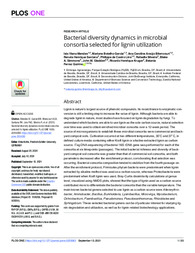Bacterial diversity dynamics in microbial consortia selected for lignin utilization.
Bacterial diversity dynamics in microbial consortia selected for lignin utilization.
Author(s): MENDES, I. V.; GARCIA, M. B.; BITENCOURT, A. C. A.; SANTANA, R. H.; LINS, P. de C.; SILVEIRA, R.; SIMMONS, B. A.; GLADDEN, J. M.; KRUGER, R. H.; QUIRINO, B. F.
Summary: Abstract:Lignin is nature?s largest source of phenolic compounds. Its recalcitrance to enzymatic conversion is still a limiting step to increase the value of lignin. Although bacteria are able to degrade lignin in nature, most studies have focused on lignin degradation by fungi. To understand which bacteria are able to use lignin as the sole carbon source, natural selection over time was used to obtain enriched microbial consortia over a 12-week period. The source of microorganisms to establish these microbial consortia were commercial and backyard compost soils. Cultivation occurred at two different temperatures, 30°C and 37°C, in defined culture media containing either Kraft lignin or alkaline-extracted lignin as carbon source. iTag DNA sequencing of bacterial 16S rDNA gene was performed for each of the consortia at six timepoints (passages). The initial bacterial richness and diversity of backyard compost soil consortia was greater than that of commercial soil consortia, and both parameters decreased after the enrichment protocol, corroborating that selection was occurring. Bacterial consortia composition tended to stabilize from the fourth passage on. After the enrichment protocol, Firmicutes phylum bacteria were predominant when lignin extracted by alkaline method was used as a carbon source, whereas Proteobacteria were predominant when Kraft lignin was used. Bray-Curtis dissimilarity calculations at genus level, visualized using NMDS plots, showed that the type of lignin used as a carbon source contributed more to differentiate the bacterial consortia than the variable temperature. The main known bacterial genera selected to use lignin as a carbon source were Altererythrobacter, Aminobacter, Bacillus, Burkholderia, Lysinibacillus, Microvirga, Mycobacterium, Ochrobactrum, Paenibacillus, Pseudomonas, Pseudoxanthomonas, Rhizobiales and Sphingobium. These selected bacterial genera can be of particular interest for studying lignin degradation and utilization, as well as for lignin-related biotechnology applications.
Publication year: 2021
Types of publication: Journal article
Unit: Embrapa Agroenergy
Observation
Some of Embrapa's publications are published as ePub files. To read them, use or download one of the following free software options to your computer or mobile device. Android: Google Play Books; IOS: iBooks; Windows and Linux: Calibre.
Access other publications
Access the Agricultural Research Database (BDPA) to consult Embrapa's full library collection and records.
Visit Embrapa Bookstore to purchase books and other publications sold by Embrapa.

